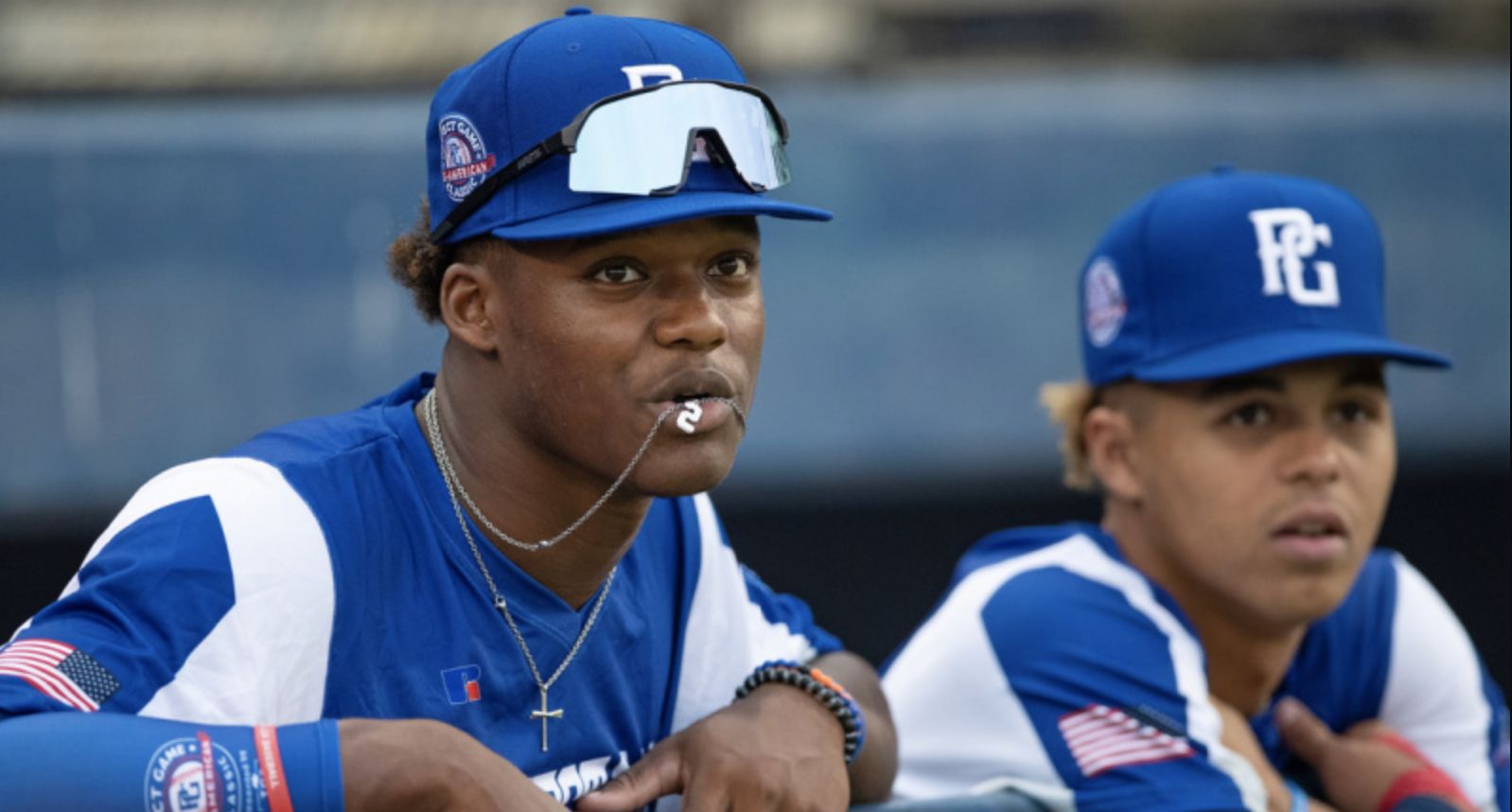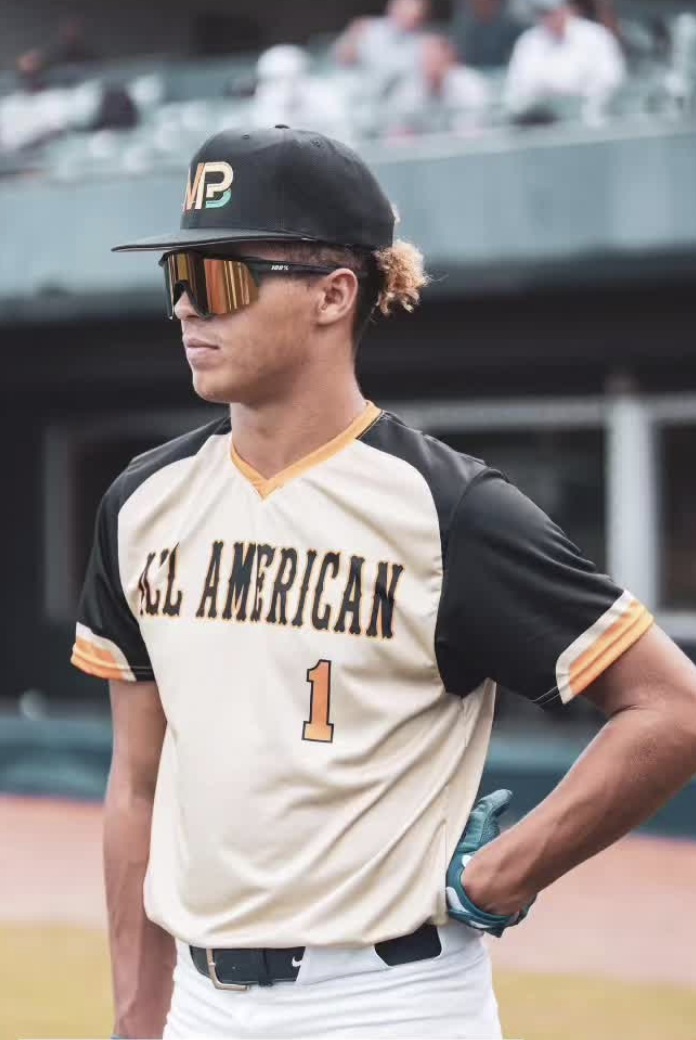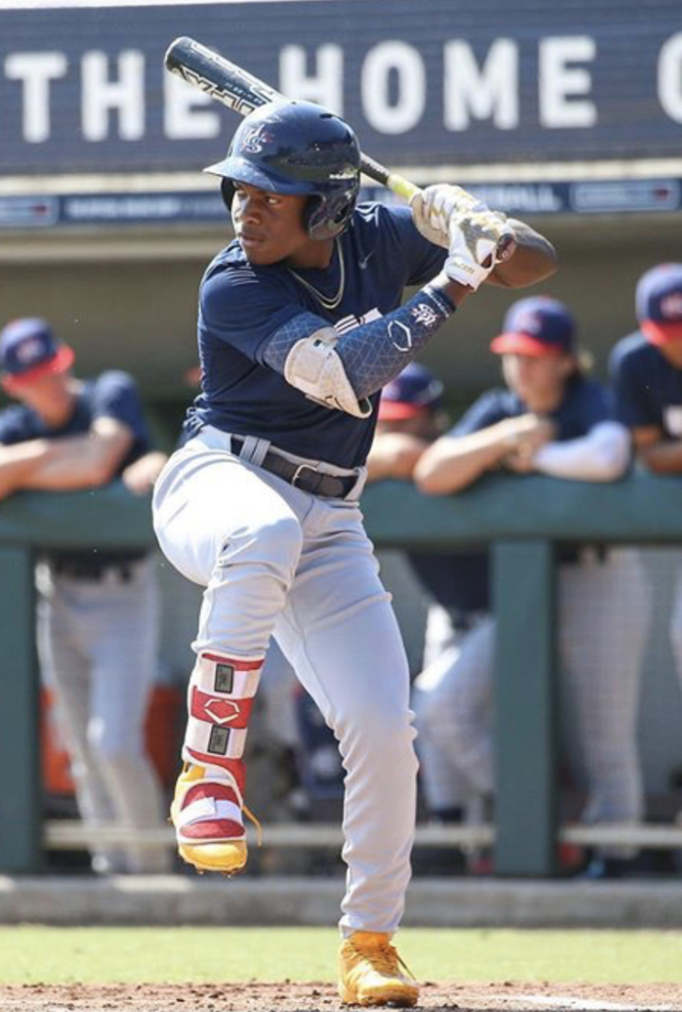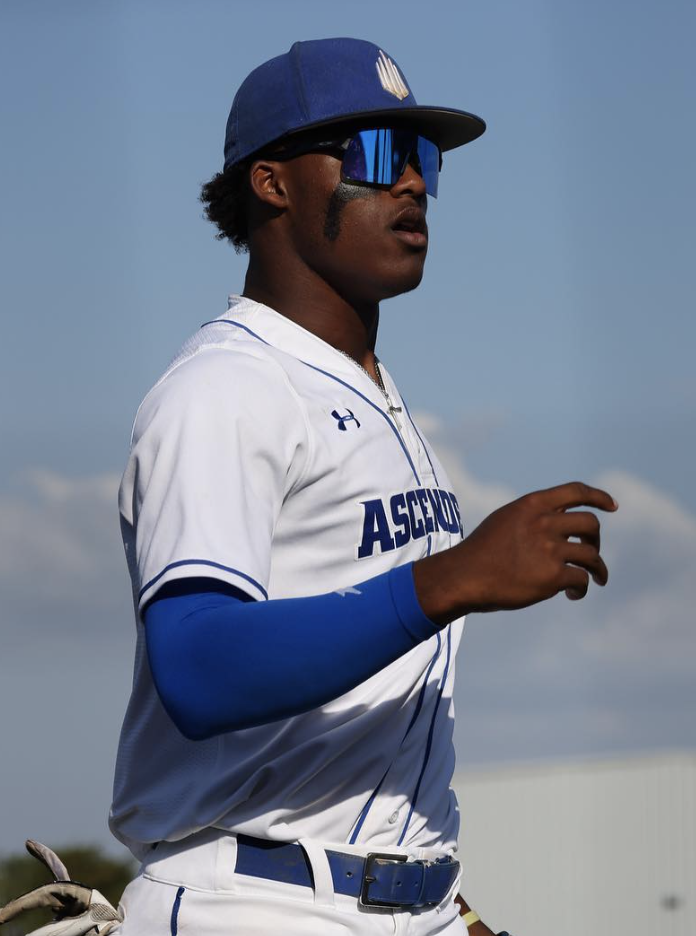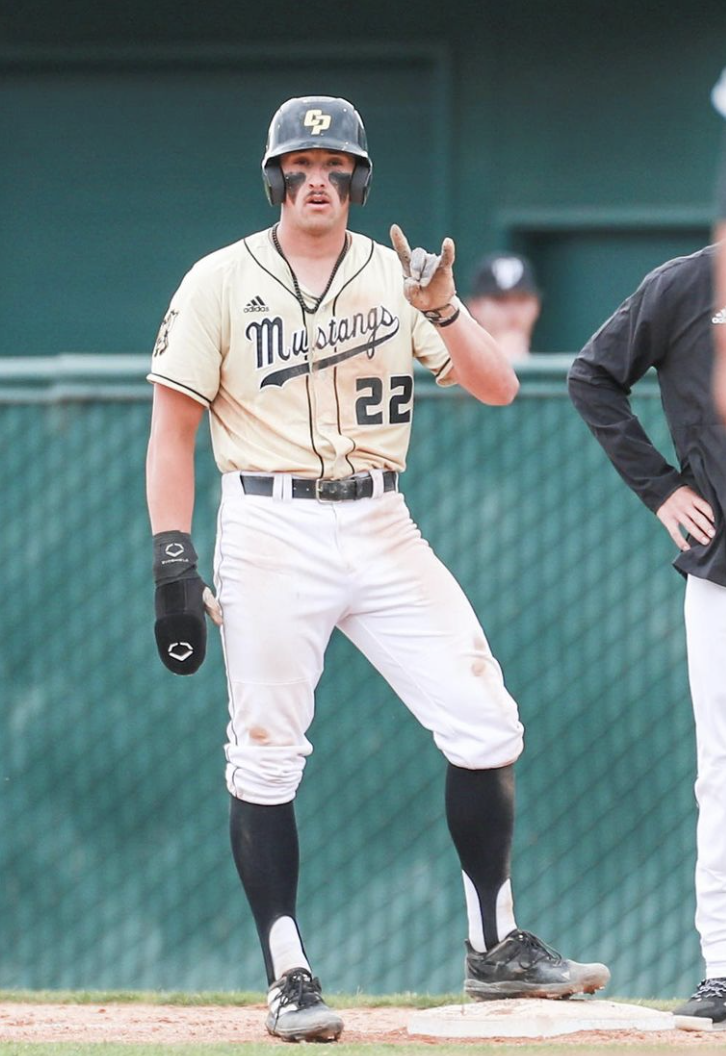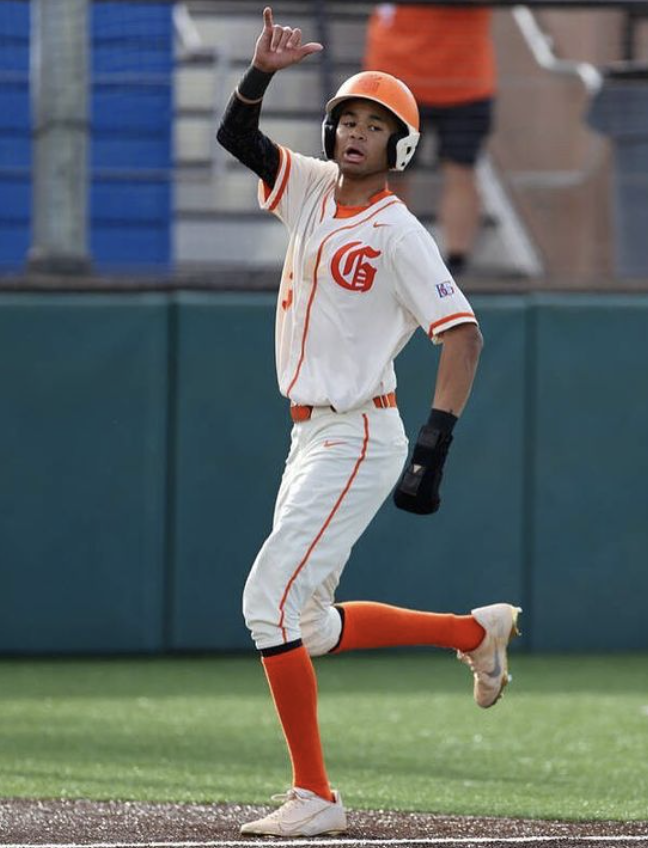2022 MLB Draft - Mock Draft 2.0
Mock Draft 2.0 is Here!
Mock Draft 2.0 is Here!
Let’s make one thing clear straight out the gates: we’ve got three months to go.
With that being said, things are starting to heat up a bit.
Mock drafts are inherently futile, especially three months out from the actual draft itself. College ball is at the halfway mark and we’re yet to see how some of the premier high school athletes in the north are going to look coming out of an important winter of lifting and training. That said, industry dialogue is beginning to build, and thus, Mock Draft 2.0.
It’s a good year to be picking in the top ten. There’s a steady dosing of college performers and big bats, as well as a handful of high school bluechips with superstar upside.
1. Baltimore Orioles
Druw Jones, Outfield, Wesleyan
What a perfect year for General Manager Mike Elias and Co.™ to be drafting no. 1 overall. A class chockfull of talent on both the college and high school side, Baltimore could go any number of directions. In this case, we think Elias grabs the lanky, projectable high school star with mammoth upside in Jones. While the Orioles have preferred to go with under-slot college bats of late, when given the opportunity to select a franchise cornerstone, Elias selected Carlos Correa no. 1 overall in 2012. Granted, that was a signing bonus haircut too. If we know anything about the Orioles, they’ll chase a deal when in-between choices. Jones has superstar upside and will almost assuredly stay up the middle of the field. Orioles brass have been spending an awful lot of time scouting Jones, as well as Elijah Green and Termarr Johnson. At this stage, it would surprise us if they went the college route in 2022.
2. Arizona Diamondbacks
Termarr Johnson, Infield, Mays
The Diamondbacks and Scouting Director Deric Ladnier have not been shy with selecting high-upside preps in recent years and we believe that trend continues here with Johnson. Whether it be Corbin Carroll, Matt McLain, Blake Walston or Jordan Lawlar, Arizona has a type. They’re seeking stars and building a robust talent pool for the future, specifically up the middle. There may not be a better hitter than Johnson in this class. Yes, there’s some concern on his size and sustainability at shortstop, but Johnson is a good bet to stay up the middle and hit at the top of the lineup. Elijah Green makes some sense here too, but we think Jackson Holliday is the dark horse. Should the Diamondbacks zig when we expect them to zag, Georgia Tech catcher Kevin Parada is a name to watch.
3. Texas Rangers
Jackson Holliday, Shortstop, Stillwater
The Rangers seem reasonably honed in on up-the-middle talent and Holliday deserves to be in the same conversation as the “Big 3” preps in this class at this point. It seems any of Jones, Johnson and Holliday all fit the mold of what Texas has tried to accomplish in drafts of late, while Green’s streaky hit tool might preclude him from the other three from this chair. Holliday has a shot to be an average defensive shortstop with a strong arm, though the bat is what scouts rave over. Holliday has the potential to be an above average hitter with above average power at a position that now demands offensive production. Holliday has a pedigree in the game (son of Matt Holliday), a characteristic trait that has gained steam of late with the continued success of so many second and third-generation big leaguers.
4. Pittsburgh Pirates
Kevin Parada, Catcher, Georgia Tech
The Pirates have focused on staying up the middle of the field in the first round the last few years, and that should come as no surprise as it’s Ben Cherington’s M.O. going back to his days in Toronto. Parada ranks as the best college bat on the board and, despite selecting Henry Davis with the first overall pick in 2021, you can never have enough premium bats in your system. The addition of the NL designated hitter should make this conversation moot anyways. Parada has the potential to be a 60-hitter and a 60 power bat in a future lineup that could feature Davis, Parada, Nick Gonzales and Oneil Cruz. Things are starting to come together for Pittsburgh.
5. Washington Nationals
Elijah Green, Outfield, IMG Academy
This is where the Green slide, if you can even call it that, ends. He makes a ton of sense at a couple spots before this, but it’s hard to imagine him falling outside of the top five picks with his late season surge at IMG. There may not be a player with more pure upside in this class. Green could eventually be a guy who hits .270 with 40 homer power. Getting that type of value at pick no. 5 is pretty exciting for Mike Rizzo and the Nationals. The bat aside, Green has a chance to stick in centerfield with at least plus run times and a double-plus arm that would comfortably shift to right field when necessary. The ability to pair Green with Brady House in a potential 2025-and-beyond lineup should have Nats fans raving.
6. Miami Marlins
Jace Jung, Third Base, Texas Tech
The Marlins have been a bit all over the place of late. Outfield… infield… pitching… college… preps. It’s a bit all over the map both in terms of profile and model. For that reason, we’ve got Miami selecting one of the best hitters in the class in Jung. The kid can really hit. It might be a 60 hit, 60 power combo. The Marlins don’t have an obvious anchor at third base in the intermediate future. Jose Salas could take the reins, but that is far from a given. Jung isn’t a reach either. He might be the best player on the board in this scenario and he may move quick. Brooks Lee also makes sense here, though the Marlins have valued batted-ball data of late and Jung hits the ball harder than his Cal Poly counterpart.
7. Chicago Cubs
Brooks Lee, Shortstop, Cal Poly
The Cubs are an impossibly difficult club to predict. On one hand, Carter Hawkins helped build a long competitive run in Cleveland through the prep ranks. He jumped for Daniel Espino back in 2019, and Dylan Lesko could be Chicago’s first crown jewel in that same bucket. On the other, with Lee on the board, it’s a tough ceiling/floor combo to pass up. Lee is probably the best pure hitter in the college class. He lacks some of the punch of some of the other college bats on the board, but his bat-to-ball is elite. Lee should be a very quick-mover through the Cubs system with a chance to break camp with Chicago in 2024. He can handle shortstop or third base immediately and fits in the front-half of any lineup.
8. Minnesota Twins
Gavin Cross, Outfield, Virginia Tech
If history is any indication, the Twins and Gavin Cross are a match made in heaven. The Hokies slugger is one of the bigger bats in the class with massive exit velos and the ability to work mature at-bats. He’s got a good arm and can run too, a profile suited well for right field. He’s a future middle-of-the-order bat from the left side. Cross is cut from the same cloth as Trevor Larnach, Alex Kiriloff, Aaron Sabato and Brent Rooker. It’s definitely a “type” for the Twins. Minnesota jumped at the opportunity to grab Chase Petty in 2021, and while he’s since been moved to Cincinnati, Scouting Director Sean Johnson could replicate that effort by selecting Dylan Lesko here too. The Twins have lacked a true ace for quite some time. Lesko could soon be the answer to those woes.
9. Kansas City Royals
Dylan Lesko, Right-Handed Pitcher, Buford
Lesko falling to no. 9 would be a huge win for Dayton Moore and the Kansas City Royals. Some have called the standout righty the best prep pitcher evaluated since Dylan Bundy; the best high school arm in over a decade. Bundy went down with some arm soreness this spring, ending his season a little early, and that may push a couple teams off of him. That said, the performances were so exquisite, and the track record is so long and decorated, whoever ends up with Lesko is going to be very happy. It’s a potential plus fastball with a 70-grade changeups and two above average breaking balls. He’s an outstanding talent and could be one of the quickest moving high school arms ever should he stay healthy. Pairing Lesko with guys like Frank Mozzicato, Ben Kudrna, and Asa Lacy, it’s easy to be excited for a long competitive window in KC.
10. Colorado Rockies
Jordan Beck, Outfield, Tennessee
If we know one thing about the Colorado Rockies and General Manager Bill Schmidt, it’s that they love power. The insistence to keep CJ Cron on board, their efforts to acquire Randall Grichuk, even some of the late-round selections in 2021; it all points to an added emphasis on adding thump. Beck might have the best usable power in the college ranks this season, some calling it 70-grade raw juice. He’s an average hitter with sneaky athleticism in right field and a big throwing arm. In essence, Beck is the prototype right fielder in today’s game. He’s got a shot to be Colorado’s “Hunter Renfroe” for a very long time. If not Beck, Arizona catcher Daniel Susac makes a whole lot of sense here too.
11. New York Mets
Blade Tidwell, Right-Handed Pitcher, Tennessee
Awarded the 11th overall pick after failing to sign Kumar Rocker, the Mets still have their organic 14th overall pick to play with as well after this. Tidwell represents one of the best pitching prospects in the country with prototype size, athleticism and stuff that should entice New York brass… and they need pitching. The Mets pick twice in the first round, so it’s a shot to land two impact players. Tidwell was banged up in the first half of this season, but he’s come back and is pitching multiple innings for the Volunteers with the stuff every bit what folks expected. He’s been 94-96, touching 98 with an above average slider and flashes a changeup. Gabriel Hughes may be a dark horse here as well. After the college arms, watch out for high school hurlers like Noah Schultz and Andrew Dutkanych.
12. Detroit Tigers
Daniel Susac, Catcher, Arizona
The Tigers have dominated recent drafts thanks to hefty bonus pools and high draft picks. The organization is positioned for success very soon and we think Susac is definitely a good fit. The product of Roseville, California is carried by a big bat and leveraged by his leadership and admiration from his pitching staff and peers. He can hit, he’s got juice, and he can certainly stick behind the plate with a solid average arm and sneaky athleticism. Al Avila and the Tigers organization love big conference performers and Susac has a track record of performing in the Pac-12. It wouldn’t surprise us to see the Tigers continue to bolster their future down the road by jumping on a talented high school arm here either. The team has been showing Oswego LHP Noah Schultz a lot of attention.
13. Los Angeles Angels
Cooper Hjerpe, LHP, Oregon State
The Angels went awfully hard on pitching in 2021 and we expect that to take place once again in 2022. Ideally, the Angels would like to find a college arm for this spot, but as things currently stand, it’s not the most robust talent pool at the top. Still, Hjerpe is a bit of a data-darling with unicorn-type metrics in his low release and elite approach angle. He’s a polarizing prospect who will require advanced player development techniques, leveraging his unique ability to maximize his future impact. There’s an above average slider and a solid average changeup here too. If the Angels are convinced Hjerpe can start, this is a good spot and a good value. Gonzaga RHP Gabriel Hughes makes sense here too, as does Brebeuf Jesuit RHP Andrew Dutkanych if they’re willing to dip into the prep ranks.
14. New York Mets
Andrew Dutkanych IV, RHP, Brebeuf
It’s not secret the Mets covet pitching in this draft (and last years draft) and it’s an awfully good year to splurge on high schoolers. Dutkanych has seen his stuff tick into a different bucket this spring, sitting 93-95, up to 97 and holding his velocity into the late innings of his games. He’s got a high-spin slider with deep two-plane break that figures to settle in at least plus at the next level. Ultimately, we’re talking about a guy with two weapons on the mound and has shown a feel for a changeup in the past. Dutkanych has some of the biggest upside in the class and would be a fun project for the Mets player development system. Watch out for Cam Collier here as well.
15. San Diego Padres
Brandon Barriera, LHP, IMG Academy
The Padres have made their preference for selecting high-upside preps quite obvious in recent years and we believe with the dearth of high school arms available in this class, they go that route again. Barriera is an uber-athletic lefty with a sinking fastball into the high 90s and a plus slider. While he doesn’t have the biggest frame in the class, his unprecedented arm speed and athleticism suggest there may be more in the tank with definitive starter traits. Some have compared the bluechip southpaw to a young Marcus Stroman from the left side. Barriera gets high marks for his competitive streak and leadership. Barriera has suitors in the top five picks as well, though he wasn’t quite as dominant this spring as some anticipated.
16. Cleveland Guardians
Noah Schultz, LHP, Oswego East
The 6-foot-9-inch Schultz may be the most unique arm in the 2022 class. Guys his age and size and don’t generally have the body control and feel for the strike zone that Schultz possesses, but alas, he certainly does. The fastball has been up to 97, but the bread and butter may ultimately be a slurvy breaking ball with mammoth spin rates and big two-plane break. He’s shown feel for turning over a changeup as well. The Guardians spent three years optimizing Andrew Miller and may have good idea of what to do with Schultz straight out of the gate. He’s missed some time this spring, but it’s hard to imagine teams turning down the upside and unique operation that Schultz brings to the mound.
17. Philadelphia Phillies
Chase DeLauter, Outfield, James Madison
While we rank DeLauter among the best prospects in the country, there’s no denying his polarizing profile due to an unconventional swing. DeLauter was the best player in the Cape Cod League this past summer showcasing massive power, plus run times and a huge arm in the field. He’s got a shot to stick in centerfield early in his career, though his profile is well-suited for right field as well. He had a mammoth season before breaking his foot in April, ending the campaign. From this chair, DeLauter is a Top 10 prospect in the class whose only question mark revolves around a Kyle Tucker-esque swing that scouts believe is susceptible to velocity up in the zone. DeLauter makes sense, but so do guys like Dylan Beavers, Zach Neto, Jackson Ferris and Brock Porter, given the Phillies recent track record.
18. Cincinnati Reds
Cam Collier, 3B, Chipola College
There are those in the industry who believe Collier is a top five player in this class, and it’s easy to see why. Collier will be 17 years old at the draft, and he won’t turn 18 until almost Thanksgiving this year. Despite his age, Collier has torn up the JUCO scene this spring, hitting at the top of Chipola’s lineup for the entire season. He projects a potential plus hitter with solid average power; a middle of the lineup thumper. Collier has a plus arm at third base and a big, strong, physical presence on the diamond. He’s a powder-keg player with a bright future who should be able to stick at third base, so long as his physicality and powerful frame don’t slow him down. Imagining Collier driving in guys like Austin Hendrix, Jay Allen and Matt McLain in the future should excite Reds fans.
19. Oakland Athletics
Brock Porter, RHP, Orchard Lake St. Mary’s
The Athletics have been heavy on the prep side in recent years and, with the rebuild in full effect should feel no pressure to draft from the college ranks in 2022. Oakland has had several scouts and cross-checkers in to see Porter throw recently, and have certainly haven’t been afraid to go with cold-weather arms in the past. Porter has the potential for 4 pitches, though he’s already got supreme feel for a fastball up to 99 and a bugs bunny changeup that projects double-plus at as a pro. Porter has seen his breaking ball tick in the right direction this spring with two plane break, flashing above average and consistently landing as an average weapon.
20. Atlanta Braves
Jett Williams, SS, Rockwell-Heath
Williams is a spark-plug middle infielder with sensational bat to ball skills and surprising juice for his size. There are those in the industry who believes Williams has the best hit tool among the “second tier” of the high school bats. He’s your prototype top-of-the-lineup bat who can stick at shortstop, though a shift to second base would see his defense tick up into the plus territory. There figures to be a good year on day one for “hitterish” prep infielders and Williams, for our money, will be the first off the board after Holliday and Johnson at the top. It does feel like Atlanta is a favorable landing spot for some of the injured college pitchers too. Alabama lefty Connor Preilipp fits well here, as does a healthy Gabriel Hughes out of Gonzaga.
21. Seattle Mariners
Zach Neto, Shortstop, Campbell
This is certainly an ideal situation for the Mariners. Their 2021 draft suggests the team is switching focus from college pitching to a more up-the-middle approach to draft amateur talent. Neto has a lot of suitors prior to this spot, so it remains to be seen if he falls this far. Neto checks just about every box on the scouting report, though a huge leg kick and divisive swing will keep some teams away. Seattle is in needs of advanced infield prospects with their competitive window opening. Neto could move quick and potentially contribute in 2024. It’s at least an average hit tool with above average power, an above average run tool and average tools on the dirt. Mix in an 80-grade mentality and instincts on the field and it’s easy to see why teams like him. If Neto is off the board, keep an eye on prep shortstop Jett Williams and Max Martin. Oklahoma State RHP Justin Campbell could be a dark horse here.
22. St. Louis Cardinals
Tucker Toman, Third Base, Hammond
I’m not sure if there’s a more “Cardinals pick” than Tucker Toman. He’s a power-first infield prospect with an average hit tool and the ability to move around the diamond with traits that fit in a number of places. Toman is a switch-hitter, though he’s far more dangerous from the left side with above average power and plus bat speed. He’s got the tools to be a fringy shortstop, though most think he fits best as a solid average third baseman. The Cardinals have been heavy on a lot of different preps in this class in recent weeks, though we think the buck stops with Toman.
23. Toronto Blue Jays
Gabriel Hughes, RHP, Gonzaga
Hughes has seen a slow climb all season long as a result of performance, stuff, and impressive ZOOM calls with scouts trying to get a feel for the player. Hughes is a fiery competitor with good athleticism and untapped potential in terms of pitch shape and mechanics. At his best, Hughes has been up to 97 with arm-side run. He’s got a slider and a curveball, though they can melt together when he doesn’t get through the ball. Hughes also features a changeup. Hughes has a chance to be a solid no. 2 or no. 3 starter at the big league level with two plus pitches if he can iron out consistent shape for his pitches.
24. Boston Red Sox
Drew Gilbert, Outfield, Tennessee
Gilbert has been one of the best pure performers in the SEC this season showcasing an impressive hit tool, budding power and twitchy tools all over the field. Gilbert gets extremely high marks for his competitive fire and is regarded as one of the more intense players in college baseball. He plays an above average centerfield with an average arm and plus run times. In total, we’re talking about a guy with a smattering of solid average tools, fantastic makeup, and bat speed that could translate into game power as he continues to get a feel for what he’s capable of. Gilbert is a fantastic player and could move quickly through the Red Sox system with his mature approach.
25. New York Yankees
Jacob Berry, 1B, LSU
There’s no questioning whether Berry is one of the best bats in the country. The hit tool projects plus, and the power is there as well. Berry has a solid approach and he doesn’t strike out, more than willing to take his walks along the way. The only reason Berry lasts this long is he’s a bit position-less. He’s gotten run at third base and right field, though neither have seemed to be a natural fit. Most scouts believe he’s a first baseman at the pro level, though he could get away with playing in a short right field at Yankee Stadium. New York has drafted strong college performers of late, and his big lefty stroke would fit well in the Yankees lineup for a long, long time.
26. Chicago White Sox
Jackson Ferris, LHP, IMG Academy
Ferris is considered by many a fit in the top ten picks, though a streaky spring has pushed him down a few boards. It’s really not so much an indictment on how Ferris has played, but more so the strength of arguably the greatest high school pitching class of all time. The White Sox haven’t been afraid to draft high school pitching in the past, and Ferris could be the best arm they’ve ever grabbed. It’s a potential plus fastball and a plus curveball with a fringy changeup that’s been on-again, off-again at best. Ferris has been up to 97 from the left side, though he’s generally more 92-93. It’s long levers with impressive athleticism and a track record of performance. Ferris has ace potential if it all aligns. Keep an eye out for OF Ryan Clifford here. A deeper cut, Clifford may be an attractive under-slot option to the Sox.
27. Milwaukee Brewers
Dylan Beavers, OF, Cal
The Brewers have drafted almost exclusively college performers at the top of their most recents drafts, and while the system could use an infusion of pitching, we think they stay the course and grab another upside bat. Beavers is likely a corner outfielder, but he’s a good athlete and a strong runner who has at least a shot of playing centerfield at the next level. It’s plus raw power and he’s getting to a lot of it in-game right now. While Beavers has a strong approach, there is some swing and miss and it’s likely just an average hit tool. He also possesses a plus throwing arm in the grass. Beavers has a chance to be the heir apparent to Christian Yelich in due time.
28. Houston Astros
Walter Ford, RHP, Pace
This is a massively important draft for the Astros as it represents their first opportunity to draft in the first and second round since 2019. The Astros system is certainly a bit anemic right now, though that could change this summer, leaning on a strong high school pitching crop in infuse upside into their future. Ford has an electric fastball, up to 98, generally sitting 93-95. He’s got a wicked breaking ball that projects plus at the next level as well. Ford has fringy command and there’s some effort in the delivery, but Houston is lauded for their pitching development and it stands to reason they could turn Ford into an absolute beast as a pro. Also worth noting, Ford won’t turn 18 until the year 2023 after reclassifying into the 2022 class. He’s extremely young and extremely talented.
29. Tampa Bay Rays
Maximus Martin, SS, Moorestown
The Rays are always in a position to get creative in the draft, taking a little more risks than most in an attempt to find controllable young stars, prying the competitive window open indefinitely. Martin certainly fits the Rays mold. He’s a good hitter with explosive bat speed. He’s also an above average, maybe even a plus runner who can add value all over the diamond. Martin is a solid shortstop, though his skillset could fit anywhere on the diamond, including in left field or centerfield should the Rays find themselves in a logjam in 2025 and beyond. Should Jett Williams still be on the board, he too makes a ton of sense. Others to watch here include Justin Crawford, son of Carl who played for Tampa for much of his career, as well as Orange Lutheran’s Mikey Romero.
30. San Francisco Giants
Thomas Harrington, RHP, Campbell
The Giants like leaders, they like upside and they want to see big, strong, college performers, Harrington has been that and then some in 2022, leading the staff at Campbell. He’s got a great body, projection, and budding stuff featuring a sinker fastball up to 97, but more commonly 91-94. His breaking ball has taken a massive step forward in 2022, though it’s his changeup that many consider to be his biggest weapon. Harrington has the upside of a mid-rotation arm that could move quickly in the Giants system thanks to sublime command and a green, upward trajectory. His best baseball is ahead of him.
31. Colorado Rockies
Roman Anthony, Outfield, Stoneman Douglass
Anthony saw a meteoric rise this spring after showcasing increased physicality and athleticism across all aspects of his game. He projects a plus power bat from the left side with an average hit tool. Anthony has a huge arm in and should fit beautifully in a corner for Colorado for years to come. He’s an average runner, maybe a tick better, though speed will likely never be a leverageable tool as a pro. An Ole Miss commit, Anthony has likely done enough this spring to really lower much chance of him ever making it to campus.
32. Cincinnati Reds
Henry Bolte, Outfield, Palo Alto
The Reds seem insistence to cut payroll certainly lends to the narrative that they’re pausing their competitive window, at least for the time being. Having taken Collier in the first round, we have the Reds going prep again in round two with talented centerfielder Bolte. A potential 5-tool player, Bolte has a short, compact swing that plays to all fields with physicality in the box. He projects an average-or-better hitter with solid average power. He’s an above average runner in center with a strong arm, capable of handling centerfield, but could also comfortably shift to right field if necessary. A Texas Longhorns commit, Bolte won’t come cheap, but this is the type of player the Reds can team with Jay Allen in 2025 and beyond, creating an awfully impressive young outfield core.
33. Baltimore Orioles
Cade Doughty, Second Base, LSU
The Orioles have had a knack for drafting college performers and we have that continuing after going with Druw Jones with the first overall pick. Doughty has been one of the better pure hitters in college baseball this season and has the versatility to play anywhere on the infield for the O’s. His best position is second base. Doughty doesn’t get the most gaudy exit velocities, largely average, though he optimizes launch at the plate and should get into average power as a pro. Frankly, it’s similar to the path Alex Bregman took a handful of years ago. Florida 3B/RF Sterlin Thompson makes a lot of sense here as well.
34. Arizona Diamondbacks
Gavin Turley, Outfield, Hamilton
32 picks after selecting Termarr Johnson, we have the Diamondbacks sticking with the tact of taking tools over everything. Turley deserves to be in that conversation of next-level talent and intangibles. It’s elite, elite bat speed with plus run times and a fantastic arm in the field. There are still questions on the polish of the hit tool, but Turley is cut from the same cloth as Bo Bichette from his high school days. The tools are loud, the upside is immense and if it all clicks, you’ve got an all-star caliber firecracker in the field.
35. Kansas City Royals
Connor Prielipp, LHP, Alabama
Arkansas second baseman Robert Moore obviously becomes a talking point here as the son of General Manager Dayton Moore, but I think KC goes college pitching here. 18 months ago, Prielipp was a very legitimate option to go first overall in the 2022 draft, and while that’s more unlikely today than it was back then, his talent is still through the roof. It’s a pro body with a sinking fastball up to 96, feel for a changeup and a very good slider. Prielipp has pitched just 28 innings in his college career, just 7 of those coming since 2020. Still he’s just about 100% ready to rock and roll now and could conceivably pitch in professional ball in 2022. Landing this type of talent in the compensatory rounds could be one of the best values of the draft.
36. Pittsburgh Pirates
Justin Crawford, Outfield, Bishop Gorman
Crawford, the son of former Rays great Carl, is just as tooled-up as his dad, and might be a faster runner too. Crawford has a slasher swing with plus bat speed and definitive over-the-fence power when he extends and lifts. With the swing as presently constructed, his homers will come almost exclusively to the pull-side. Crawford is a sprinter and can certainly handle centerfield, though some think his profile will best fit in a corner due to fringy arm strength. The Pirates have targeted elite athletes in recent drafts and they’d be awfully happy landing Crawford. A Vanderbilt commit with a family of fame and lineage, it remains to be seen how signeable he is.
37. Cleveland Guardians
Connor Staine, RHP, Central Florida
The Guardians have had a knack for grabbing pitchers in the early rounds with appealing data and untapped potential mechanically. Staine is that in spades. A fastball with major hop into the mid-90s, plus a short, tight slider in the mid-80s and a loopier curveball, Staine seems to ooze potential. It’s a lean, strong, pro body who could eventually end up throwing into the upper-90s. Cleveland would be a fantastic landing spot for Staine and he could reach his mid-rotation ceiling with proper development and refinement of his command.
38. Colorado Rockies
Justin Campbell, RHP, Oklahoma State
Campbell really feels like the type of arm the Rockies have targeted in the second and third round in recent drafts. He’s a big-time performer with a premier body and the feel for a changeup that can really thrive in Denver. Campbell has been up to 97 though he rests lower than that. He’s got two distinct breaking balls with some metric appeal. Campbell joining the likes of Jaden Hill and Chris McMahon from the past two seasons should make for a trio of pro starters that will contribute at Coors in the not-too-distant future.
39. San Diego Padres
Mikey Romero, Shortstop, Orange Lutheran
Romero, a San Diego native, is exactly what the Padres look for each year in the draft, and one would have to imagine both parties would be thrilled to join forces. Romero has some of the best bat-to-ball skills in the class, a potential plus hitter as a pro. We’re talking about a guy cut from the same cloth as Adam Frazier and Kevin Newman. We tend to think there’s a little more thump there, possibly an Asdrubal Cabrera type of player. Romero is an above average shortstop with an average arm that should be able to handle the position as a pro. Romero is the rare high-floor prospect who should be a no-doubt pro. He also comes from a fantastic baseball/softball family.
40. Los Angeles Dodgers
Landon Sims, RHP, Mississippi State
The Dodgers are no stranger to selecting data-monsters and Sims certainly fits that billing despite undergoing Tommy John surgery this spring. Sims has a high-90s fastball with immense hop and a strong ability to command the pitch. His slider took a small step back in 2022, but flashed double-plus grades in 2021 in a relief role. It remains to be seen if Sims can start as a pro, but the Dodgers are just the type of team who see a high-leverage reliever here who should move quick as a pro once healthy. It’s also possible they save a bit of money with the pick to splurge on a high-end prep in round two.

